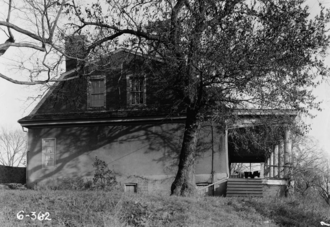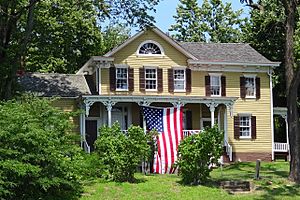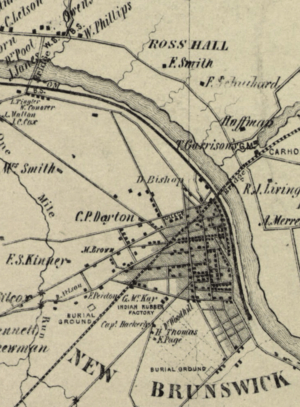Ross Hall facts for kids
Quick facts for kids Ross Hall |
|
|---|---|

1936 HABS Photo
|
|
| General information | |
| Status | Destroyed |
| Location | River Road and Ross Hall Boulevard, Piscataway, New Jersey |
| Coordinates | 40°30′39″N 74°26′55″W / 40.51083°N 74.44861°W |
| Named for | Dr. Alexander Ross |
Ross Hall was an old, important farmhouse in Piscataway, New Jersey. It was built around 1739 by Edward Antill. This is why it was also known as the Edward Antill House. In 1768, Dr. Alexander Ross bought the house, and it was named after him.
In July 1778, during the American Revolutionary War, General George Washington used Ross Hall as his main office. From here, he ordered a special celebration called a feu de joie (which means "fire of joy") to mark the second birthday of the Declaration of Independence.
Contents
History of Ross Hall
The land where Ross Hall stood was first bought in 1688 by Edward Antill, a lawyer. His son, also named Edward Antill (who lived from 1701 to 1770), inherited the large property, which was about 370 acres. He built the house for his family.
On June 10, 1739, Edward Antill married Anne Morris. She was the daughter of Lewis Morris, who was the Royal Governor of New Jersey. Their first child, Sarah, was born at Ross Hall on August 18, 1740. Because of these events, people believe the house was built either in late 1739 or early 1740.
Edward Antill was a busy farmer. He had a huge apple orchard with 500 apple trees! He used the apples to make cider at his own distillery.
In 1768, Dr. Alexander Ross bought the property. The house then became known as Ross Hall, named after him. Dr. Ross passed away in 1775.
Over the years, Ross Hall had several different owners. In 1880, George W. Metlar bought the property. After 1897, Ross Hall was used as a clubhouse for the New Brunswick Golf Club until 1925.
Rutgers University owned Ross Hall in the 1950s. Sadly, the house was damaged by a fire in 1954 and was completely taken down in 1957.
What Ross Hall Looked Like
Ross Hall was a two-story house made of brick. It had a strong stone foundation and a special type of roof called a gambrel roof. Its design was a mix of two styles: Georgian and Dutch colonial farmhouse.
George Washington's Headquarters
After the Battle of Monmouth on June 28, 1778, General George Washington and his Continental Army marched north. They went to the Raritan River near New Brunswick to get cool, fresh water. The army set up camp on both sides of the river. General Washington chose Ross Hall as his headquarters.
A Special Independence Day Parade
From Ross Hall, General Washington planned a big celebration. It was for the second anniversary of the Declaration of Independence. He ordered a feu de joie, which was a special firing of guns and cannons.
On July 3, 1778, Washington gave these orders:
Tomorrow, the Anniversary of the Declaration of Independence will be celebrated by the firing thirteen Pieces of Cannon and a feu de joie of the whole line; the Army will be formed on the Brunswick side of the Rariton at five o'Clock in the afternoon on the ground pointed out by the Quarter Master General. The Soldiers are to adorn their Hats with Green-Boughs and to make the best appearance possible. The disposition will be given in the orders of tomorrow. Double allowance of rum will be served out.
—George Washington, July 3, 1778
The next day, July 4, 1778, Washington gave more details for the celebration:
After the Army is formed, upon a signal by order of the Commander in Chief, thirteen Pieces of Cannon will be discharged, after which a single Cannon which will be a signal for a tuning fire to begin on the right of the Army and be continued to the left with Musquetry and Cannon. At the Conclusion of which, on a signal, three Cheers will be given, "Perpetual and undisturbed Independence to the United States of America."
—George Washington, July 4, 1778
Someone who was there described the event:
My situation being high and at a convenient distance in front, afforded me a complete view of the whole, and presented by far the grandest sight I ever beheld. The running fire of musketry is grand of itself, but the cannon throwing out their columns of smoke, and adding their sounds at proper distances, made it magnificent beyond description.
Ross Hall's Legacy

Today, Ross Hall Boulevard in Piscataway is named after the historic property.
One of the parlor walls from Ross Hall has been saved. It will be shown in a special educational area at the nearby Metlar-Bodine House Museum.
On July 4, 1976, a memorial stone was placed where River Road and Sutphen Road meet. This stone marks the route of the first Independence Day parade from 1778.



